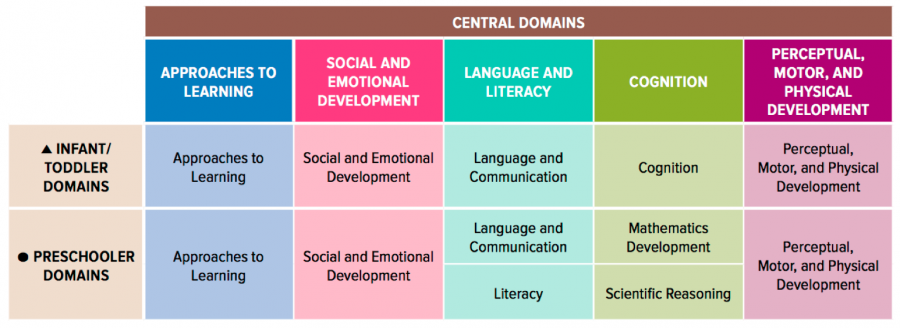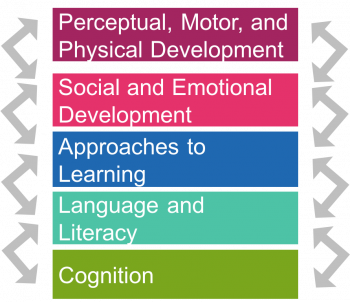1-1 Head Start Early Learning Outcomes Framework
A – Introducing the ELOF
This section looks at the Head Start Early Learning Outcomes Framework (HSELOF), also sometimes called the ELOF, and its five central domains: Approaches to Learning; Social and Emotional Development; Language and Literacy; Cognition; and Perceptual, Motor, and Physical Development.
This is a guiding framework to help educators in all kinds of early learning settings learn about the skills, behavior, and knowledge to foster in all young children.
The Head Start Early Learning Outcomes Framework (HSELOF) is a resource that describes children’s developmental progressions from birth to age 5. The framework will guide the activities in this course as you explore children’s development across domains. One version of the framework is interactive. Click to view the interactive framework.

The framework supports the learning and development of all children, including children who are dual language learners and those who have disabilities. It guides curriculum selection, implementation, and assessment and can be a tool for planning and assessing teaching and learning experiences and children’s progress toward school readiness goals.
Framework Guiding Principles
The Head Start Early Learning Outcomes Framework, based on the latest research in child development, has a set of guiding principles. These are the exact words from the framework as referenced below:
- Each child is unique and can succeed. Children are individuals with different rates and paths of development. Each child is uniquely influenced by their prenatal environment, temperament, physiology, and life experiences. With the appropriate support, all children can be successful learners and achieve the skills, behaviors, and knowledge described in the Framework.
- Learning occurs within the context of relationships. Caring families, educators, and other adults matter in a young child’s life. Responsive and supportive interactions with adults are essential to children’s learning.
- Families are children’s first and most important caregivers, teachers, and advocates. Families must be respected and supported as the primary influence in their child’s early learning and education. Their knowledge, skills, and cultural backgrounds contribute to children’s school readiness.
- Children learn best when they are emotionally and physically safe and secure. Nurturing, responsive, and consistent care helps create safe environments where children feel secure and valued. In these settings, children can engage fully in learning experiences.
- Areas of development are integrated, and children learn many concepts and skills at the same time. Any single skill, behavior, or ability may involve multiple areas of development. For example, as infants gain fine motor skills, they can manipulate objects in new ways and deepen their understanding of cause and effect. As preschoolers gain new verbal skills, they can better manage their emotions and form more complex friendships.
- Teaching must be intentional and focused on how children learn and grow. Children are active, engaged, and eager learners. Good teaching practices build on these intrinsic strengths by providing developmentally appropriate instruction and opportunities for exploration and meaningful play.
- Every child has diverse strengths rooted in their family’s culture, background, language, and beliefs. Responsive and respectful learning environments welcome children from diverse cultural and linguistic backgrounds. Effective teaching practices and learning experiences build on the unique backgrounds and prior experiences of each child.
Video: The Head Start Early Learning Outcomes Framework (2:05)
This brief video introduces the framework and ways to use it to support children’s development.
Download the video transcript [PDF] from the Early Childhood Learning & Knowledge Center (ECLKC).
B – Domains of Development
Approaches to Learning
The Approaches to Learning domain focuses on the skills and behaviors that children use to learn about the world.
This domain includes four subdomains:
- Emotional and Behavioral Self-Regulation,
- Initiative and Curiosity,
- Creativity, and
- Cognitive Self-Regulation.
Children show behavior in this domain through their emotional reactions, their behavior choices, and their ability to focus attention. For example, the framework indicates that by 36 months, children will:
- Use strategies, such as seeking familiar adults or removing themselves from situations, to handle strong feelings and emotions. (Emotional and Behavioral Regulation subdomain)
- Maintain focus and attention on a simple task or activity for short periods of time. (Cognitive Self-Regulation subdomain)
Social and Emotional Development
The Social and Emotional Development domain focuses on children’s abilities to create meaningful relationships with other people; to express, recognize, and manage their own emotions; and to respond to others’ feelings.
This domain includes four subdomains:
- Relationships with Adults,
- Relationships with Other Children,
- Sense of Identity and Belonging, and
- Emotional Functioning.
Language and Literacy
The Language and Literacy domain focuses on children’s developing abilities to listen, understand, and express themselves using language, and skills that lay the foundation for reading and writing.
The domain for infant and toddlers is Language and Communication with these subdomains: Attending and Understanding, Communicating and Speaking, Vocabulary, and Emergent Literacy.
In preschool, Language and Literacy are separate domains to reflect the differences in development in these areas. The Language and Communication subdomains for preschoolers are: Attending and Understanding, Communicating and Speaking, and Vocabulary. The Literacy domain has these subdomains: Phonological Awareness, Print and Alphabet Knowledge, Comprehension and Text Structure, and Writing.
This domain includes the skills needed to communicate effectively with others. Children’s proficiency with language and literacy affects their learning across all domains over time.
Cognition (Birth to 3)
The Cognition domain focuses on the development of reasoning, memory, problem-solving, and thinking skills.
This domain has these subdomains for infants and toddlers:
- Exploration and Discovery,
- Memory,
- Reasoning and Problem-Solving,
- Emergent Mathematical Thinking, and
- Imitation and Symbolic Representation and Play.
Cognition (Ages 3 to 5)
For preschoolers, the Cognition domain becomes two: Mathematics Development and Scientific Reasoning. This reflects the increasingly complex and unique cognitive abilities of children ages 3 to 5.
Within Mathematical Development, the subdomains are:
- Counting and Cardinality,
- Operations and Algebraic Thinking,
- Measurement, and Geometry and Spatial Sense.
Within Scientific Reasoning, the subdomains are:
- Scientific Inquiry and
- Reasoning and Problem-Solving.
Perceptual, Motor, and Physical Development
The Perceptual, Motor, and Physical Development domain is key to children’s development because these areas allow children to explore and learn in others. The domain includes three subdomains:
- Perception
- Gross Motor, Fine Motor
- Health Safety and Nutrition
Domains and Connections

Each domain connects to and influences the others.
For example, as preschoolers’ working memory develops (part of Approaches to Learning), their ability to follow multiple-step instructions improves and their ability to learn complex math concepts (part of Cognition) increases. Or, as children develop their skills engaging in multi-turn conversations, their ability to describe social problems and suggest solutions to conflicts (part of Social and Emotional Development) also grows.
C – What You’ll Learn in the Course
Course Sessions
This course book is the companion content to the online and in-person Child Development: Brain Building (CDBB) course. Sessions 3 through 11 will focus specifically on the five central developmental domains in the framework: Approaches to Learning, Social and Emotional Development, Language and Literacy, Cognition, and Perceptual, Motor and Physical Development. The framework shows the continuum of learning for infants, toddlers, and preschoolers and describes what skills, behaviors, and knowledge that you should support to help children grow.
Video: CDBB Course Structure (2:41)
 References
References
U.S. Department of Health and Human Services, Administration for Children and Families, Office of Head Start. (n.d.). Head Start Early Learning Outcomes Framework: Ages Birth to Five. [PDF]
U.S. Department of Health and Human Services, Administration for Children and Families, Office of Head Start (n.d.). Getting started with the Head Start Early Learning Outcomes Framework. [PDF]
U.S. Department of Health and Human Services, Administration for Children and Families, Office of Head Start. (n.d.). Head Start Early Learning Outcomes Framework: Ages Birth to Five. [Video]
EarlyEdU Alliance (Publisher). (2018). 1-1 Head start early learning outcomes framework. In Child Development: Brain Building Course Book. University of Washington. [UW Pressbooks]

